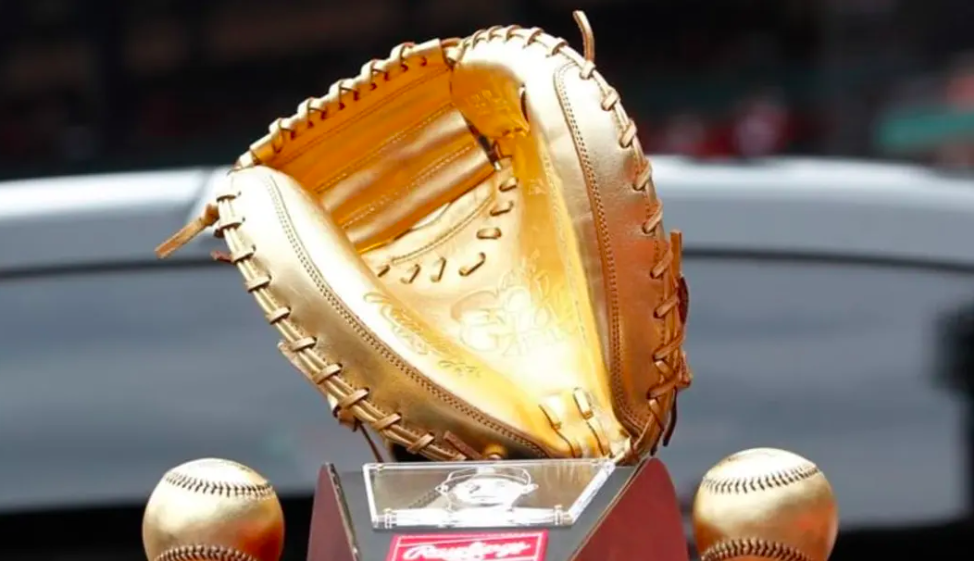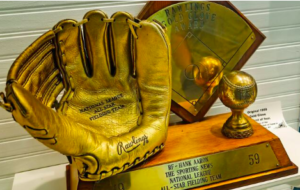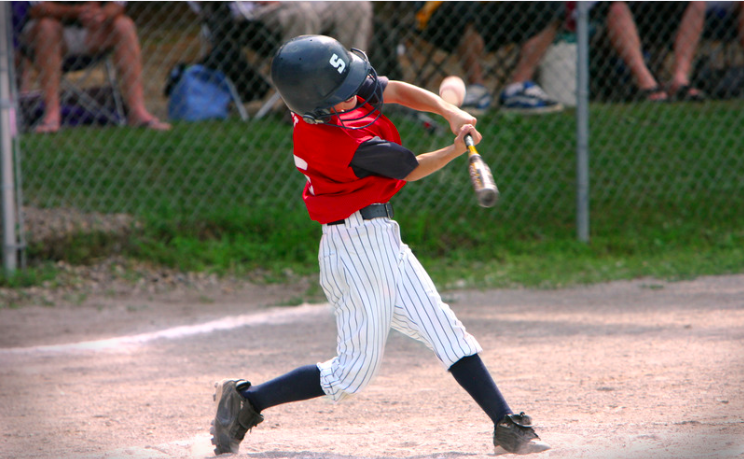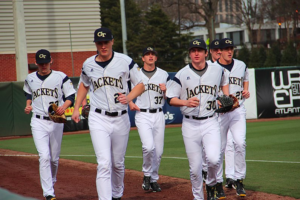Baseball
Gold Glove Award: The Pinnacle of Defensive Excellence in Baseball

Gold Glove Award: The Pinnacle of Defensive Excellence in Baseball
The Gold Glove Award is one of the most prestigious accolades in Major League Baseball (MLB), celebrating players who have demonstrated exceptional defensive skills. This award, synonymous with fielding prowess, has become a benchmark for excellence and a coveted recognition for baseball athletes. In this article, we delve into the history, significance, notable winners, and impact of the Gold Glove Award in the world of baseball.
History of the Gold Glove Award
Origins and Evolution
The Gold Glove Award was established in 1957 by the baseball glove manufacturer Rawlings. The award aimed to honor the best defensive players at each position in both the American League (AL) and the National League (NL). The inaugural winners included baseball legends like Brooks Robinson and Willie Mays, setting a high standard for future recipients.
Criteria and Selection Process
Initially, the selection process for the Gold Glove Award relied solely on the votes of MLB managers and coaches. However, this method evolved over the years to include advanced defensive metrics and statistical analysis. Today, the selection combines votes from managers and coaches (who cannot vote for their own players) with sabermetrics, ensuring a more comprehensive evaluation of defensive performance.
Significance of the Gold Glove Award

Recognition of Defensive Excellence
Winning a Gold Glove Award is a testament to a player’s defensive prowess. It signifies a player’s ability to prevent runs, make difficult plays look routine, and contribute significantly to their team’s success through exceptional fielding.
Boost to Career and Legacy
The award enhances a player’s reputation and can significantly impact their career trajectory. Players who consistently win Gold Glove Awards are often viewed as elite defenders, which can lead to increased contract values, endorsements, and a lasting legacy in the sport.
Notable Gold Glove Award Winners
Brooks Robinson: The Human Vacuum Cleaner
Brooks Robinson, often referred to as “The Human Vacuum Cleaner,” won 16 consecutive Gold Glove Awards from 1960 to 1975. His remarkable ability to field at third base set a benchmark for defensive excellence.
Ozzie Smith: The Wizard
Ozzie Smith, known as “The Wizard” for his acrobatic plays at shortstop, secured 13 Gold Glove Awards during his illustrious career. Smith’s defensive skills were a cornerstone of his Hall of Fame career.
Roberto Clemente: The Complete Player
Roberto Clemente, an exceptional right fielder, won 12 Gold Glove Awards. His ability to make spectacular catches and powerful throws made him a defensive legend.
Keith Hernandez: Defensive Maestro at First Base
Keith Hernandez, widely regarded as one of the best defensive first basemen in MLB history, won 11 Gold Glove Awards. His adept fielding and quick reflexes redefined the expectations for first basemen.
Gold Glove Award Categories

Infield Positions
- First Base: Recognizes the top defensive player who excels in fielding ground balls, making picks, and positioning.
- Second Base: Highlights players known for their range, double-play capabilities, and quick transitions.
- Shortstop: Celebrates athletes with exceptional range, strong arms, and the ability to make highlight-reel plays.
- Third Base: Honors those with quick reflexes, strong arms, and the ability to field hard-hit balls.
Outfield Positions
- Left Field: Recognizes players who excel in fielding fly balls, strong throws, and preventing extra-base hits.
- Center Field: Celebrates players with exceptional range, speed, and the ability to cover vast outfield territory.
- Right Field: Highlights those with strong throwing arms, range, and the ability to make accurate throws to home plate.
Catcher and Pitcher
- Catcher: Honors those who excel in blocking pitches, throwing out base stealers, and handling pitchers.
- Pitcher: Recognizes pitchers who excel in fielding their position, making plays on bunts, and covering first base.
The Role of Advanced Metrics
Introduction of Sabermetrics
The inclusion of sabermetrics has revolutionized the way defensive performance is evaluated. Metrics such as Defensive Runs Saved (DRS), Ultimate Zone Rating (UZR), and Fielding Independent Pitching (FIP) provide a more accurate assessment of a player’s defensive contributions.
Impact on Gold Glove Selections
The integration of these advanced metrics into the selection process ensures that the Gold Glove Award is awarded to truly deserving players. It reduces subjectivity and highlights players who might have been overlooked based on traditional statistics alone.
Controversies and Debates

Subjectivity in Voting
Despite improvements, the selection process has faced criticism for subjectivity. Managers and coaches may have biases, and fan favorites sometimes overshadow deserving candidates. The inclusion of advanced metrics aims to mitigate these issues but has not entirely eliminated controversy.
Defensive Shifts and Their Impact
The rise of defensive shifts has also influenced Gold Glove selections. Players who excel in shifted positions might not receive due recognition, as traditional fielding positions become less defined. This evolution in defensive strategy has sparked debates about the criteria for the award.
Impact on Teams and Fans
Boosting Team Morale
Having a Gold Glove winner on a team boosts overall morale. Exceptional defensive plays can change the momentum of a game, inspire teammates, and contribute to a winning culture.
Fan Engagement and Entertainment
Gold Glove winners often become fan favorites, celebrated for their highlight-reel defensive plays. These players draw fans to the ballpark, enhance the viewing experience, and create memorable moments in baseball history.
The Future of the Gold Glove Award
Evolving Criteria and Technology
As technology continues to advance, the criteria for the Gold Glove Award will likely evolve further. The use of Statcast data, which tracks player movements and reaction times, provides even deeper insights into defensive performance. This data can refine the selection process, ensuring that the most deserving players are recognized.
Global Expansion
With baseball gaining popularity worldwide, the Gold Glove Award could expand to include international leagues. Recognizing defensive excellence globally would enhance the award’s prestige and reflect the growing influence of baseball on the international stage.
Conclusion
The Gold Glove Award stands as a symbol of defensive excellence in Major League Baseball. From its origins in 1957 to its current status, the award has celebrated the best fielders in the game, setting a high standard for defensive play.
Winning a Gold Glove not only recognizes a player’s skill and dedication but also cements their legacy in baseball history. As the game evolves, so too will the criteria and technology used to determine the winners, ensuring that the Gold Glove Award remains a prestigious and coveted accolade in the world of sports.
Frequently Asked Questions (FAQs)
How is the Gold Glove Award determined?
The Gold Glove Award is determined through a combination of votes from MLB managers and coaches, who cannot vote for their own players, and advanced defensive metrics like Defensive Runs Saved (DRS) and Ultimate Zone Rating (UZR).
Has anyone won the Gold Glove Award in multiple positions?
Yes, some players have won the Gold Glove Award at multiple positions. For instance, Darin Erstad won the award as an outfielder and a first baseman, showcasing his versatility and defensive prowess.
What is the significance of advanced metrics in Gold Glove selections?
Advanced metrics provide a more comprehensive and objective evaluation of defensive performance. Metrics like DRS and UZR help identify players who make significant contributions to their team’s defense, reducing the subjectivity in the voting process.
How has the Gold Glove Award evolved over the years?
The Gold Glove Award has evolved by incorporating advanced defensive metrics into the selection process, ensuring a more accurate assessment of players’ defensive abilities. This evolution reflects the changing dynamics of the game and the importance of data-driven analysis.
What impact does winning a Gold Glove have on a player’s career?
Winning a Gold Glove enhances a player’s reputation, boosts their marketability, and can lead to increased contract values and endorsements. It also cements their legacy as one of the best defenders in the game, contributing to their overall career achievements.
Baseball
What Are The Basic Rules of Baseball?

What Are The Basic Rules of Baseball?
Baseball, often referred to as America’s favorite pastime, is a sport deeply rooted in tradition and history. At its core, baseball is a game of strategy, skill, and athleticism played between two teams of nine players each. From the crack of the bat to the roar of the crowd, baseball captures the hearts of fans worldwide with its rich traditions and timeless appeal.
In this article, we’ll explore the fundamental rules that govern the game of baseball, from the basics of team composition to the intricacies of scoring and gameplay. Whether you’re a seasoned fan or new to the sport, understanding these rules is key to enjoying the excitement and drama that unfold on the diamond. So, grab your glove and join us as we delve into the exciting world of baseball!
Team Composition: Of Baseball
In baseball, team composition refers to the arrangement of players on the field, each with specific roles and positions. Understanding the team composition is essential for both players and spectators to grasp the dynamics of the game. Let’s delve into the detailed piece on the team composition of baseball:

- Pitcher: The pitcher is a crucial player responsible for throwing the ball to the opposing team’s batters. They stand on the pitcher’s mound, which is a raised area in the center of the field, and aim to deliver pitches that are difficult for batters to hit.
- Catcher: Positioned behind home plate, the catcher receives pitches from the pitcher and plays a pivotal role in the defensive strategy. They catch pitches, block balls in the dirt, and attempt to throw out baserunners attempting to steal bases.
- Infielders: There are four infielders who play close to the bases – first base, second base, shortstop, and third base. Their primary objective is to field ground balls hit by the opposing team’s batters, make throws to other infielders or the first baseman, and prevent baserunners from advancing.
- First Baseman: Positioned near first base, this player receives throws from other infielders and attempts to tag the batter or step on the base to record outs.
- Second Baseman: Positioned near second base, they cover the area between first and second base and play a crucial role in double plays and fielding ground balls hit to the right side of the field.
- Shortstop: Positioned between second and third base, the shortstop is often considered the team’s defensive captain, responsible for covering a large area of the infield and making quick throws to get outs.
- Third Baseman: Positioned near third base, they field ground balls hit to the left side of the field and play a crucial role in defending against bunts and making strong throws to first or second base.
- Outfielders: There are three outfielders positioned in the outfield – left field, center field, and right field. Their primary responsibility is to catch fly balls hit by the opposing team’s batters and prevent extra-base hits.
- Left Fielder: Positioned in left field, they cover the area between third base and center field and make throws to infielders or the catcher to prevent baserunners from advancing.
- Center Fielder: Positioned in center field, they cover a large area of the outfield and are often considered the team’s best defensive outfielder, capable of making long throws and catching difficult fly balls.
- Right Fielder: Positioned in right field, they cover the area between first base and center field and are responsible for fielding balls hit to the right side of the outfield and making accurate throws to prevent baserunners from scoring.
Understanding the roles and positions of each player in baseball’s team composition is essential for executing defensive strategies, making plays, and ultimately achieving success on the field.
Objective: of Baseball
The objective of baseball is simple yet intricate: to score more runs than the opposing team by successfully hitting the ball, advancing around the bases, and preventing the opposing team from doing the same. Let’s delve into a detailed piece on the objective of baseball:

- Scoring Runs: The primary objective of the offensive team in baseball is to score runs. A run is scored when a player successfully crosses home plate after touching all four bases in a counter-clockwise direction: first base, second base, third base, and finally home plate. To score a run, players must hit the ball into play, advance around the bases, and reach home plate safely before the opposing team can record three outs.
- Offensive Strategies: Various offensive strategies are employed to score runs, including hitting, bunting, and base running. Hitters aim to make solid contact with the ball and hit it into fair territory, allowing them to safely reach base and potentially advance to subsequent bases. Bunting involves intentionally tapping the ball with the bat to softly place it in play, often used to advance baserunners or surprise the defense. Base running involves skillfully navigating the base paths, anticipating opportunities to advance, and capitalizing on defensive mistakes.
- Defensive Strategies: The objective of the defensive team is to prevent the opposing team from scoring runs. Defensive players strategically position themselves to field balls hit into play, make accurate throws to record outs, and minimize the advancement of baserunners. Pitchers play a crucial role in disrupting the opposing team’s offense by throwing a variety of pitches to keep hitters off balance and induce outs.
- Pitching and Defense: The pitcher is a key defensive player responsible for throwing pitches to opposing batters. The catcher works closely with the pitcher to call pitches, frame pitches effectively, and control the opposing team’s running game. Infielders and outfielders work together to field balls hit into play, make throws to record outs, and prevent baserunners from advancing.
- Game Strategy and Tactics: Baseball is a game of strategy and tactics, with managers and players constantly making decisions to gain a competitive advantage. Offensive strategies may include stealing bases, hitting-and-running, and sacrifice flies, while defensive strategies may involve shifting infielders, employing defensive alignments, and making strategic pitching changes.
- Winning the Game: The ultimate objective of baseball is to win the game by outscoring the opposing team. A game typically consists of nine innings, with each team having the opportunity to bat and play defense. The team with the most runs at the end of the game is declared the winner. In the case of a tie, extra innings may be played until a winner is determined.
Overall, the objective of baseball is to showcase skill, strategy, and teamwork while competing to score more runs than the opposing team and ultimately emerge victorious.
Duration: of Baseball
In baseball, the duration of a game can vary depending on several factors, including the level of play, game situation, and any potential delays. However, there are standard guidelines for the duration of a typical baseball game. Here’s a breakdown of the duration in different contexts:
- Regulation Game: A regulation baseball game consists of nine innings for each team, with each inning comprising both a top and bottom half. In professional and most amateur leagues, each inning typically lasts until three outs are recorded for each team. The duration of an inning can vary based on factors such as the number of pitches thrown, hits, walks, and defensive plays.
- Inning Length: The length of an inning can vary significantly depending on the offensive and defensive performance of both teams. An inning with multiple hits, walks, and runs scored may take longer to complete due to the increased action on the field. Conversely, an inning with quick outs and minimal baserunners may be completed more swiftly.
- Pitching Changes: Pitching changes can also impact the duration of a baseball game. When a team makes a substitution to bring in a new pitcher, there is typically a delay as the new pitcher warms up on the mound. Additionally, the length of each at-bat and the number of pitches thrown by each pitcher can affect the overall pace of the game.
- Commercial Breaks: In professional baseball games, commercial breaks between innings and during pitching changes contribute to the duration of the game. These breaks allow broadcasters to air advertisements and generate revenue but can extend the length of the game, especially in televised broadcasts.
- Game Delays: Inclement weather, equipment malfunctions, or other unforeseen circumstances can cause delays during a baseball game. Rain delays, in particular, can result in lengthy interruptions as players and officials wait for favorable playing conditions to resume the game.
- Extra Innings: If the score is tied at the end of nine innings, the game may proceed to extra innings to determine a winner. Extra innings extend the duration of the game, with each additional inning providing another opportunity for either team to score and secure victory.
Overall, the duration of a baseball game can vary, but a regulation game typically lasts around two to three hours. However, factors such as inning length, pitching changes, commercial breaks, and game delays can influence the overall length of the game.
Field of Play: in Baseball
The field of play in baseball, often referred to as the baseball diamond or the baseball field, is the designated area where the game is conducted. It consists of several key components, each serving a specific purpose in the game. Here’s a detailed look at the field of play in baseball:
- Infield: The infield is the central area of the field where most of the action in baseball takes place. It includes the following components:
- Pitcher’s Mound: Located in the center of the infield, the pitcher’s mound is a raised area from which the pitcher delivers pitches to the batter.
- Home Plate: Positioned at the center of the infield, home plate serves as the starting and ending point for each batter’s turn at bat.
- First Base: Situated to the right of home plate, first base is the initial base that a baserunner must reach to safely advance.
- Second Base: Positioned to the right of first base, second base is the second base that a baserunner must reach to safely advance.
- Third Base: Positioned to the right of second base, third base is the third base that a baserunner must reach to safely advance.
- Base Paths: The base paths are the designated paths that baserunners must follow to advance from one base to another.
- Outfield: The outfield is the area beyond the infield where outfielders play defensive positions. It includes the following components:
- Outfield Fence: The outfield fence marks the boundary of the playing field and serves as the target for batted balls hit over the fence for a home run.
- Warning Track: The warning track is a strip of dirt or gravel located just beyond the outfield fence. It alerts outfielders that they are approaching the fence and helps prevent collisions.
- Foul Territory: Foul territory refers to the areas outside the baseline and beyond the first and third base lines. It includes the following components:
- Foul Lines: Foul lines extend from home plate to the outfield fence and mark the boundary between fair territory and foul territory.
- Foul Poles: Foul poles are vertical poles or lines located at the intersection of the foul lines and the outfield fence. They help umpires determine whether a batted ball is fair or foul.
- Dugouts: Dugouts are enclosed areas located along the first and third base lines where players and coaches from each team sit when they are not on the field. They provide shelter and seating for players and are equipped with benches, equipment storage, and communication systems.
Overall, the field of play in baseball is meticulously designed to accommodate the various aspects of the game, including pitching, hitting, fielding, and base running. Each component plays a crucial role in shaping the dynamics of the game and providing a competitive and engaging experience for players and spectators alike.
Start and Restart: of Baseball
In baseball, the start and restart of the game are pivotal moments that set the stage for the action to unfold. Understanding how the game begins and resumes after interruptions is fundamental to grasping the flow of play. Here’s a detailed overview of the start and restart procedures in baseball:
- Start of the Game:
- First Pitch: The game begins with the first pitch thrown by the pitcher from the pitcher’s mound to the batter at home plate.
- Umpire’s Call: The home plate umpire signals the start of the game by shouting “Play ball!” after ensuring both teams are ready and the field is set.
- Batting Order: The batting order determines the sequence in which players from the batting team take their turns at bat. The first batter listed in the lineup steps into the batter’s box to face the first pitch.
- Defensive Alignment: The defensive team positions players strategically on the field to anticipate hits and field the ball effectively.
- Restart of the Game:
- After a Timeout: If play is temporarily halted due to factors like weather delays, injuries, or disputes, the game restarts once the interruption is resolved.
- Umpire’s Signal: The home plate umpire indicates the resumption of play by signaling to both teams that the game is about to restart.
- Return to Action: Players return to their positions on the field, and the pitcher prepares to resume pitching to the batter.
- Pitcher’s Delivery: The pitcher resumes the game by delivering the next pitch to the batter, aiming to continue the action seamlessly.
- Subsequent Innings:
- Between Innings: At the end of each inning, there is a brief break as teams transition between offense and defense. Players return to their respective dugouts, and the next inning begins with the defensive team taking the field.
- Pitcher Change: Teams may opt to replace the pitcher at the start of a new inning or during an inning if deemed necessary. The new pitcher enters the game from the bullpen and takes over pitching duties.
- Continuation of Play: The game progresses inning by inning until the predetermined number of innings is completed or until one team emerges as the winner.
Understanding the start and restart procedures in baseball is essential for players, coaches, and spectators alike. These moments mark the beginning and resumption of the action, shaping the rhythm and intensity of the game as it unfolds inning by inning.
Ball In and Out of Play: of Baseball
In baseball, the concept of the ball being in play or out of play determines the state of the game and the actions that players can take. Here’s a detailed explanation of when the ball is considered in play and out of play:
- Ball In Play:
- The ball is considered in play when it is live and active during the course of the game.
- The ball remains in play from the moment it is pitched by the pitcher until certain events occur that render it out of play.
- While the ball is in play, players from both teams can make defensive plays, attempt to hit the ball, and advance on the bases.
- Instances When the Ball is Considered In Play:
- Pitching: When the pitcher throws the ball to the batter, the ball is in play until the pitch is caught by the catcher, hits the batter, or crosses the plate without the batter swinging.
- Hits and Fouls: After the batter makes contact with the ball, whether it results in a fair hit, foul ball, or bunted ball, the ball remains in play until specific outcomes occur, such as a catch by a fielder or the ball going out of play.
- Fielding Plays: When fielders catch a batted ball, retrieve a ground ball, or make a throw to a base, the ball is in play until the play is completed.
- Ball Out of Play:
- The ball is considered out of play when certain events occur that temporarily halt the action on the field.
- When the ball is out of play, players cannot make additional plays or advance on the bases until the ball is put back into play.
- Instances When the Ball is Considered Out of Play:
- Foul Balls: If a batted ball travels outside the foul lines, it is considered a foul ball, and the ball is immediately out of play.
- Home Runs: When a batted ball clears the outfield fence in fair territory, resulting in a home run, the ball is out of play until retrieved by a fielder or returned by a fan.
- Interference or Obstruction: If a defensive player interferes with a batter or runner or if there is obstruction by a fielder, the ball may be declared dead, and play is halted momentarily.
Understanding when the ball is in play and out of play is crucial for players, umpires, and spectators to interpret the flow of the game accurately. These rules help maintain the integrity of the game and ensure fair competition on the field.
Scoring: of Baseball
Scoring in baseball occurs when a player successfully advances around the bases and touches home plate, earning a run for their team. Here’s a detailed explanation of how scoring works in baseball:
- Scoring Runs:
- A run is scored when a baserunner successfully advances around the bases in a counter-clockwise direction and touches home plate before the defensive team can record three outs.
- Baserunners can advance from base to base by hitting the ball, stealing bases, or being driven in by a teammate’s hit.
- Each time a baserunner crosses home plate, their team is awarded one run on the scoreboard.
- Methods of Scoring:
- Hits: The most common method of scoring is through hits, where the batter safely reaches base and subsequently advances around the bases.
- Home Runs: A home run occurs when a batter hits the ball over the outfield fence in fair territory. All baserunners and the batter score runs when a home run is hit.
- Walks and Hit-by-Pitches: If a batter is awarded a base on balls (walk) or is hit by a pitch, they are awarded first base. If the bases are loaded, the batter is awarded an RBI (run batted in), and the baserunner on third base scores a run.
- Sacrifice Plays: Sacrifice hits or flies occur when a batter purposefully makes an out to advance baserunners. While the batter is out, any runs that score as a result of the sacrifice play are credited to the team.
- Earning RBIs:
- An RBI (Run Batted In) is credited to a batter when their hit or action at the plate results in a baserunner scoring a run.
- For example, if a batter hits a single with a runner on second base, and that runner crosses home plate, the batter is credited with an RBI.
- Recording Runs on the Scoreboard:
- Each time a run is scored, the team’s score is updated on the scoreboard. The total number of runs scored by each team is displayed throughout the game to track the progress of the game.
Scoring runs is fundamental to the game of baseball, as it determines which team is winning and provides an indication of offensive success. Understanding the various methods of scoring and how runs are earned helps players, coaches, and fans appreciate the strategic and dynamic nature of the sport.
Fouls and Misconduct: of Baseball
Fouls and misconduct in baseball are infractions of the rules committed by players, coaches, or team personnel during the game. Here’s a detailed explanation of fouls and misconduct in baseball:
- Types of Fouls:
- Fair Ball: A ball that is hit into fair territory between the foul lines is considered fair. Any batted ball that settles on or beyond the first or third base lines is a fair ball.
- Foul Ball: A ball that is hit outside the foul lines is considered a foul ball. If a batter hits a foul ball with two strikes, they are not called out, and the count remains the same.
- Strike: A strike is called when a batter swings at and misses a pitched ball or when a pitched ball crosses the strike zone and is not swung at by the batter.
- Player Misconduct:
- Batter Interference: If the batter interferes with the catcher’s ability to catch or throw the ball, it is considered batter interference, and the play is ruled dead.
- Runner Interference: If a baserunner interferes with a fielder’s ability to make a play, they may be called out for interference.
- Obstruction: Obstruction occurs when a fielder illegally hinders a baserunner’s progress. The baserunner may be awarded additional bases if obstructed by a fielder.
- Illegal Pitching: Pitchers are not allowed to use certain deceptive techniques, such as doctoring the baseball or employing illegal substances on their hands or the ball.
- Umpire Enforcement:
- Umpires are responsible for enforcing the rules of the game and making judgment calls on fouls and misconduct.
- Umpires signal a foul ball by extending one arm horizontally and pointing with the other hand toward foul territory.
- Umpires can eject players, coaches, or team personnel for repeated misconduct or egregious violations of the rules.
- Penalties:
- Penalties for fouls and misconduct may include calling the batter or baserunner out, awarding additional bases to the offensive team, or ejecting players from the game.
- In some cases, the game may be delayed or protested due to disputes over fouls or misconduct.
Fouls and misconduct are an inherent part of baseball, and umpires play a crucial role in ensuring that the game is played fairly and according to the rules. Understanding the different types of fouls and misconduct helps players, coaches, and fans appreciate the nuances of the game and the importance of sportsmanship and fair play.
Substitutions: of Baseball
Substitutions in baseball refer to the process of replacing one player with another during the course of a game. Here’s a detailed look at how substitutions work in baseball:
- Player Roles:
- Baseball teams consist of nine defensive players who occupy specific positions on the field: pitcher, catcher, first baseman, second baseman, third baseman, shortstop, and three outfielders (left fielder, center fielder, and right fielder).
- In addition to defensive players, teams also have a designated hitter (DH) in leagues that use the designated hitter rule. The DH bats in place of the pitcher and does not play a defensive position.
- Types of Substitutions:
- Defensive Substitutions: A defensive substitution occurs when a player is replaced on the field for defensive purposes. This may involve bringing in a specialist to play a specific position or replacing a player due to injury or fatigue.
- Pinch Hitters: A pinch hitter is a player who is substituted into the batting lineup to replace another player at the plate. Pinch hitters are often used in late-game situations to try to generate offense.
- Pinch Runners: A pinch runner is a player who is substituted into the game to run the bases for another player. Pinch runners are typically faster runners who can advance around the bases more quickly.
- Pitching Changes:
- Pitching substitutions are a crucial aspect of baseball strategy. Teams often make pitching changes to match up against opposing hitters or to provide relief for a tired or struggling pitcher.
- Relief pitchers are substituted into the game to replace the starting pitcher or another relief pitcher. These pitchers enter the game from the bullpen and have the task of pitching to opposing batters.
- Rules and Procedures:
- Substitutions must be reported to the umpire and announced to the opposing team and the official scorer.
- Defensive substitutions can be made at any time between pitches, while offensive substitutions (pinch hitters and pinch runners) must be announced to the umpire before the player enters the batter’s box or takes their position on base.
- Once a player has been substituted out of the game, they cannot re-enter the game except in specific circumstances outlined in the rules, such as injury replacements.
- Effect on Strategy:
- Substitutions play a significant role in baseball strategy, allowing managers to optimize their lineup based on matchups, game situations, and player performance.
- Managers must carefully consider the timing and impact of substitutions to give their team the best chance of success.
Overall, substitutions are a fundamental aspect of baseball, allowing managers to make strategic decisions to improve their team’s performance on the field. Understanding the rules and procedures surrounding substitutions is essential for players, coaches, and fans alike.
Winning the Game: of Baseball
Winning a baseball game involves scoring more runs than the opposing team by the end of the specified number of innings. Here’s a detailed explanation of how a team can win a baseball game:
- Scoring Runs:
- A run is scored when a player from the batting team crosses home plate after touching all four bases (first, second, third, and home) in order, without being tagged out by a defensive player.
- Players advance around the bases by hitting the ball safely, stealing bases, or being driven in by hits from teammates.
- Innings:
- A standard baseball game consists of nine innings, with each inning divided into two halves: the top half (when the visiting team bats) and the bottom half (when the home team bats).
- The team with the most runs at the end of nine innings is declared the winner. If the game is tied after nine innings, extra innings are played until a winner is determined.
- Ending the Game:
- A baseball game can end in several ways:
- Walk-Off Win: If the home team scores the winning run in the bottom half of the final inning, the game ends immediately, and the home team is declared the winner.
- Mercy Rule: In some leagues or levels of play, a mercy rule may be in effect, whereby the game ends if one team is ahead by a certain number of runs after a specified number of innings.
- Forfeit: If a team is unable to continue playing due to insufficient players, injury, or other reasons, they may forfeit the game, resulting in a win for the opposing team.
- A baseball game can end in several ways:
- Playoff and Championship Games:
- In postseason play, such as playoff series and championship games, the format may differ from the regular season. Series may consist of multiple games, and the team that wins the majority of games in the series advances to the next round.
- Championship games often have higher stakes, with the winning team crowned as the league or tournament champion.
- Tiebreakers:
- In the event of a tie in the standings at the end of the regular season, tiebreakers such as head-to-head record, run differential, or additional playoff games may be used to determine playoff seeding or qualification.
- Sportsmanship and Conduct:
- Winning a baseball game requires skill, teamwork, and sportsmanship. Players and coaches are expected to compete fairly and respectfully, adhering to the rules and regulations of the game.
- Celebrating victory is a common practice in baseball, but it should be done with respect for the opposing team and the game itself.
In summary, winning a baseball game involves scoring more runs than the opposing team within the specified number of innings. Teams must demonstrate skill, strategy, and sportsmanship to achieve victory on the field.
Conclusion
In conclusion, understanding the rules and strategies of baseball is essential for both players and fans alike. From team composition and objectives to scoring and winning the game, baseball offers a rich and dynamic experience that captivates audiences around the world.
Whether it’s the crack of the bat, the excitement of a stolen base, or the thrill of a walk-off home run, baseball continues to be a beloved sport with a timeless appeal. So, next time you’re at the ballpark or watching a game, remember the basics and enjoy the action unfold on the diamond.
-

 NBA5 months ago
NBA5 months agoLaMelo Ball Net Worth: A Comprehensive Look at the NBA Star’s Financial Empire
-

 Football6 months ago
Football6 months agoEuro 2024: Alvaro Morata Speaks Out About ‘No Respect’ in Spain
-

 Football7 months ago
Football7 months agoMeet the World Football Celebrities and Their Stories
-

 Game6 months ago
Game6 months agoThe Ultimate Guide to General Multi-Sport Events
-

 Football7 months ago
Football7 months agoSamuel Eto’o: Legendary Cameroonian Soccer Star’s Career
-

 Football6 months ago
Football6 months agoRonaldo’s Business Ventures and Investments (CR7 Brand)
-

 Wrestling3 months ago
Wrestling3 months agoJey Uso Biography and Net Worth: The Rise of a WWE Superstar
-

 Wrestling4 months ago
Wrestling4 months agoKevin Owens: The Prizefighter’s Rise to Fame and Fortune




